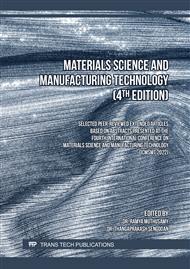p.3
p.11
p.23
p.29
p.37
p.49
p.57
p.67
Electrical Response of Ba0.7Ca0.3TiO3-BaZr0.2Ti0.8O3 Solid Solution
Abstract:
The structure, microstructure, Fourier transformed infrared spectra, dielectric, and impact generated energy harvesting characteristics of x(Ba0.7Ca0.3)TiO3–(1-x)Ba (Zr0.2Ti0.8)O3; x = 0, 0.5, and 1.0 synthesized using solid-state reaction method are discussed in this work. The X-ray diffraction (XRD) process was used to examine the forming of a single-phase compound. The Rietveld refinements of XRD data were used in FullProf software to determine crystal symmetry, lattice parameters, and space groups. A scanning electron microscope was taken into use to examine the surface morphology of all of the samples. The samples' phase transition temperature was observed to lie between-10°C and 87°C, shifting toward the higher temperature side as x increased. In the case of x = 0.5, two-phase transitions were discovered at 22°C and 70°C. The value of impact generated output voltage and electrical energy increases as applied mechanical energy increases. The findings of this study point to the possibility of using 0.5(Ba0.7Ca0.3)TiO3–0.5Ba (Zr0.2Ti0.8)O3 ceramic for energy harvesting and sensing purposes.
Info:
Periodical:
Pages:
3-9
Citation:
Online since:
October 2022
Keywords:
Price:
Сopyright:
© 2022 Trans Tech Publications Ltd. All Rights Reserved
Share:
Citation:



